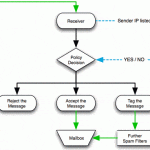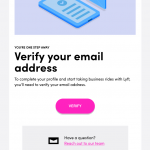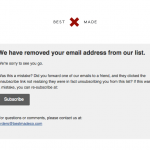Everything You Need to Know About Email Marketing Blacklists
Email marketing is an essential component of any marketer’s repertoire, but no matter how good you are at marketing – and we’re sure you’re fantastic at your job – there is one major trap you may be falling into without even realizing. Blacklists.
You’ve probably heard the word used before, whether with regards to email marketing or otherwise, and you may have asked yourself “is my email blacklisted?” but how much do you really know about it? Ok, so it’s fairly obvious that sending emails to random addresses is frowned upon, and most definitely considered spam, but you could end up on an email blacklist without actually indulging in frowned-upon email marketing practices.
To get the most from your email marketing campaigns, you should be familiar with the potential pitfalls as well as the potential gains, so we’ve put together this guide to everything you need to know about email marketing blacklists – emphasis on how to stay off them, of course. First things first,
What Are Email Marketing Blacklists?
A blacklist is a list of domain names and email addresses which have been identified as being potentially harmful. This may be due to engaging in strongly frowned-upon practices and behaviors – such as purchasing lists of email addresses to dramatically boost their numbers (more on this later) or sending unsolicited or excessive emails. These are not the only ways in which you can end up on an email blacklist, but they are certainly amongst the most common. The objective of these blacklists is to protect users from harmful or malicious content, so spamming – whether deliberate or not – is pretty much a surefire way to get yourself recognized for the wrong reasons.
Email is a powerful communication and marketing tool, but it can only retain that status through careful monitoring, hence the existence of businesses whose focus is exclusively on building and maintaining these email marketing blacklists, including:
Barracuda Reputation Blocklist – a free service which describes itself as a DNSBL of IP addresses know to send spam
Invaluement – This particular service is used to detect senders who attempt to circumvent the more traditional methods of detecting spam, and is intended to blacklist email marketing which involves unsolicited bulk mailings
MultiRBL – A free blacklist list services which cross-references other databases of blacklisted IP address and domains
Spamcop – Contains details of emails and IPs which have been reported by the service’s users
Spamhaus – This is probably the blacklist which you are most likely to encounter as you work with email marketing. Making a concerted effort to identify and track the sources of spam, Spamhaus are actively involved in providing anti-spam protection for email users
SURBL – Rather than being an actual blacklist, in the way that other services listed here are, SURBL contains lists of websites which have been included in unsolicited emails
Many large organizations also curate and use their own private email marketing blacklists, so it definitely pays to make sure your mailing list is made up of willing, consenting subscribers.
Generally speaking, the one which you are most likely to run in email marketing blacklist issues with is Spamhaus, whether due to your ISP (internet service provider) or ESP (email service provider) having been flagged as a source of potentially harmful mailings, or perhaps due to the (possibly inadvertent) use of spam trap email address on your mailing list. More about spam traps can be found later in this guide.
Although you cannot guarantee that you will never find your business on an email marketing blacklist – after all, these systems are not infallible, and mistakes do happen – it’s relatively easy to take some steps to minimize this risk. Spamhaus themselves have published a useful and informative graphic providing a basic illustration of their processes, which may help you to understand how email blacklists work. If you’re interested in more technical details, a fuller overview can be found on the Spamhaus website, under How Blocklists Work.
As you can see from the diagram, being on a blacklist is not the only reason why your email may be rejected from a particular recipient’s email account, but it is the first potential obstacle. You cannot control the policy which may determine what emails can and cannot be delivered within an organization, but you certainly can do your bit to mitigate the chances of being rejected at the blacklist stage of things.
4 Things You Must Know About Email Marketing Blacklists
1. Key Terms and Definitions
Blacklist – also referred to as a blocklist at times, this is a list of email addresses, IPs and domains which have been identified as sources of potentially harmful and/or malicious content. If you end up on an email blacklist, email providers may prevent their users from receiving mail sent from your domain.
DNS – this domain name system can be considered as the telephone directory of the internet and online service. This is how domain names and IP addresses are linked, and web traffic is directed to the correct website
DNSBL – DNS blacklist, which is what we are discussing in this article
Domain – the name of your website, e.g. activetrail.com. This is also referred to as a URL
ESP – Email Service Provider
IP address – the unique address of the server on which your email and website are hosted. This will appear as a string of numbers, such as 255.255.255.0 or similar
ISP – Internet Service Provider
Spam Traps – These are email addresses which are deliberately circulated in order to identify those domains which send to purchased mailing lists, or engage in spamming. The only way in which these pure spam traps could end up on your mailing list is if you obtained them without permission. On the other hand, there are also recycled spam traps, which may have been obtained with permission, but have since become defunct before being recycled as spam traps – hence the importance of maintaining your mailing lists regularly. You may also notice that your emails are reported as spam due to users entering a fake email address, or due to a genuine typo when subscribing.
2. Blacklists Are Not Permanent
If you do end up on an email marketing blacklist, it does not mean you will be there forever. You can use a service like MXToolbox to detect whether your domain has been identified as a source of spam. If so, some blacklist providers allow you to apply to have the entry removed, for example, Spamhaus. That said, if you do appear on a blacklist, you should definitely use it as a reminder to update your marketing strategies to avoid your campaigns being identified as bad emails by anti-spam protection, and improve your email deliverability.
3. Email Marketing Automation and Segmentation Can Help Avoid Blacklists
While you may be sending your mailings with the best of intentions, being a little lax about maintaining your mailing lists can be bad news for your email delivery. Adopting strategies and software to automate your email marketing, and segment your audience, for example, can help to avoid avoid being blacklisted.
4. Email Blacklists are a Good Thing
As an email marketing professional, you may be reading this article and getting slightly anxious about blacklists, email marketing, and the impact this may have on your business. The important thing to remember is that email blacklists are a good thing. They help to keep all of our inboxes free from spam, particularly malicious attempts at spoofing and phishing. So long as you are conscientious in your approach to sending email, you could consider these blacklists to be protection for you too – after all, without them, your marketing campaigns, which you have spent hours perfecting, would be lost in a sea of spam.
Is My Email Blacklisted? Why?
As outlined earlier, there are several reasons why you may find that your email has been blacklisted. The most common of these include:
- Using email addresses which are spam traps, or those which are deliberately included in mailing lists offered for sale, so those senders who buy lists can be easily identified.
- A genuine subscriber may have mistyped their email address, inadvertently entering one which is a spam trap.
- Your email marketing mailing list grows very quickly, without being adequately monitored for the presence of invalid or inaccurate email addresses
- A high percentage of unopened emails in your marketing campaigns, indicating that your mailing list needs to be updated. This may also be taken as a warning sign for sending unsolicited emails.
How to Avoid Email Marketing Blacklists
Even if you are trying hard to do everything by the book and operate a scrupulous, squeaky clean marketing strategy, you may accidentally fall foul of some email blacklists. Some of our top tips for avoiding being flagged as a recipient of a high number of spam complaints, sender of bad email, or otherwise coming to the attention of internet service providers (ISP), include:
- Never buying mailing lists. This is a golden rule, and must never, ever be broken. Ever.
- Make sure to use email marketing automation software which is reputable, and comes with high delivery ratings and recommendations.
- Ensure you authenticate your account before you start sending emails, particularly marketing campaigns.
- Segment your audience, meaning your subscribers only receive those marketing campaigns which are relevant to them.
- Use double opt-in on your email signup forms. Requiring new subscribers to confirm via email that they want to receive your emails reduces the risks of spam complaints.
- Optimize your marketing emails for viewing on a mobile device – yet another reason to use a reputable email marketing automation software.
- Regularly clean your subscriber list, removing anyone who has not opened an email or otherwise interacted for 3 months – this is clearly not a person who really wants to receive your marketing campaigns.
- Make it easy for subscribers to unsubscribe or request to be removed from the list – always include opt-out and unsubscribe options on your email marketing campaigns.
- If you do find that you are on a blacklist, visit MXToolbox to confirm. Request that you be removed from a blacklist (if it is possible to do so for the blacklist in question), then immediately set to work making sure you own send good email going forward.
Email blacklist could be the bane of an email marketer’s life, but only one who engages in unfavorable means of growing mailing lists or misusing the email address which has been willingly provided. They exist for our protection, and there are steps you can take to make sure you stay off those email blacklists as much as is possible.
By using a great email marketing automation software, much of this will be taken care of with minimal effort from you, meaning you’re free to spend time creating outstanding marketing campaigns, and your customers are happy to hear from you, knowing that they can trust you to send high quality, spam-free, email which is relevant to their interests.
Read more:
How to Start a Newsletter in 7 Easy Steps







